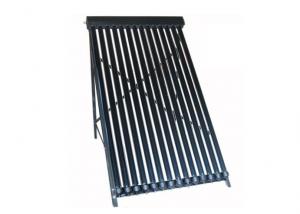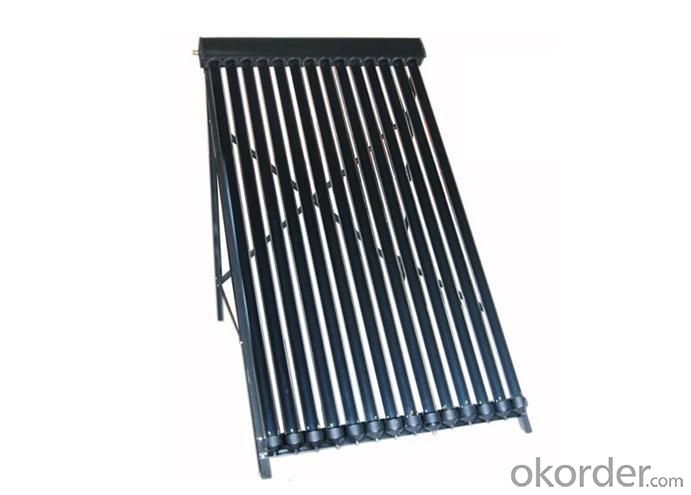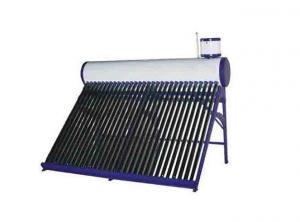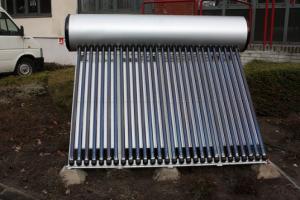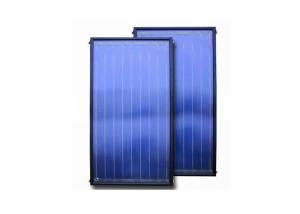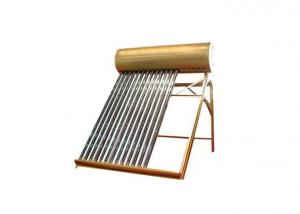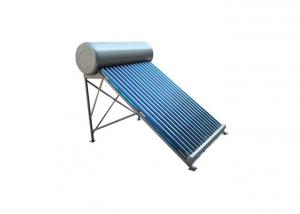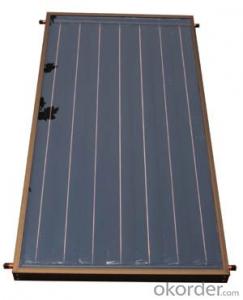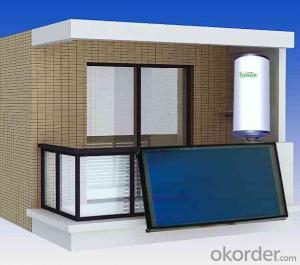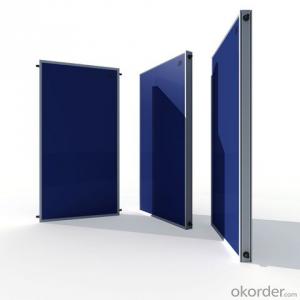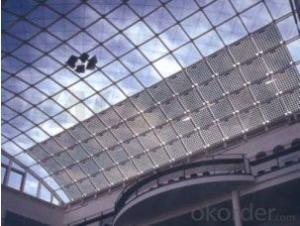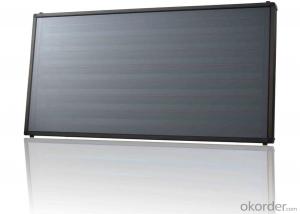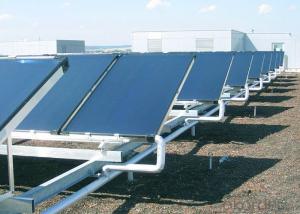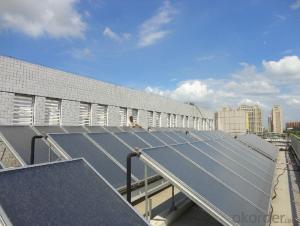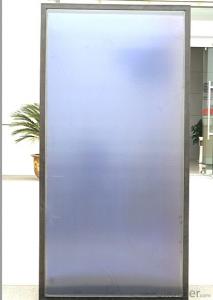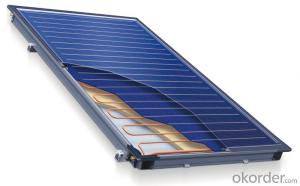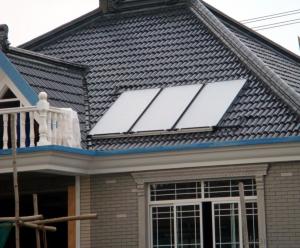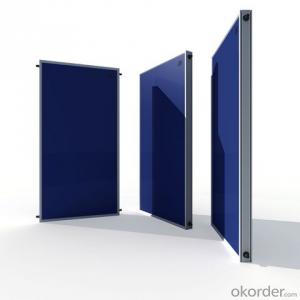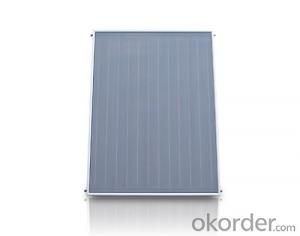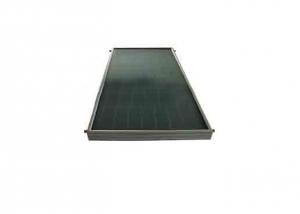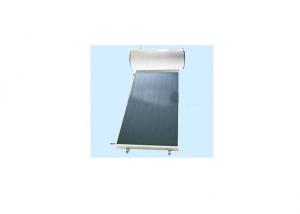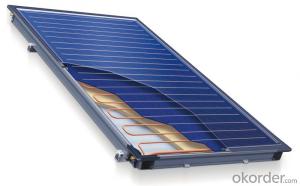Collectors Destiny Solar Collectors
- Loading Port:
- China Main Port
- Payment Terms:
- TT or LC
- Min Order Qty:
- 1 Set set
- Supply Capability:
- 3000 Sets per Month set/month
OKorder Service Pledge
Quality Product, Order Online Tracking, Timely Delivery
OKorder Financial Service
Credit Rating, Credit Services, Credit Purchasing
You Might Also Like
Detailed Product Description
1.Split pressurized solar collectors
2.On the basis of GB/T 17049-2005
3.Germany strandard
4.No slow leakage and white smoke
5.11years of manufacturing history with solar water heater and 7 years of export experience.
6.With 35 production lines, and the annual output is 12 million PCS.
7.CE,SK&SRCC owner , OEM service supply ,Fulfill large hot water needs, 5 years of warranty.
- Q: What is the classification of solar collectors?
- According to the collector heat transfer type: liquid collector, air collector. According to whether the solar radiation into the lighting port to change the direction of points: condenser type collector, non-concentrating type collector.
- Q: What is the impact of temperature variations on the performance of solar collectors?
- Temperature variations can have a significant impact on the performance of solar collectors. Solar collectors are designed to absorb sunlight and convert it into usable energy, typically in the form of heat or electricity. The temperature of the collector itself, as well as the ambient temperature, can affect the efficiency and overall output of the system. One key factor affected by temperature variations is the thermal efficiency of the solar collector. As the temperature increases, the efficiency of the collector usually decreases. This is mainly due to the increase in thermal losses, such as conduction and radiation losses. Higher temperatures can result in increased heat transfer to the surroundings, reducing the amount of energy that can be captured and utilized. Another aspect impacted by temperature variations is the efficiency of the photovoltaic (PV) cells in solar collectors that generate electricity. PV cells typically have a negative temperature coefficient, meaning their efficiency decreases as the temperature rises. This is because higher temperatures can lead to an increase in electron excitation and leakage, reducing the electrical output of the cells. Therefore, temperature control and cooling mechanisms are often employed to maintain optimal operating conditions for PV cells. Furthermore, temperature variations can affect the overall lifespan and durability of solar collectors. Excessive heat can cause thermal stress and degradation of materials, leading to reduced performance and potential failures over time. On the other hand, extremely low temperatures can also impact the performance, as they can freeze the working fluid or cause damage to pipes and components. It is important to note that the impact of temperature variations on solar collector performance can be mitigated through proper design, insulation, and control systems. For instance, implementing insulation measures can minimize thermal losses, while temperature control systems can regulate the operating conditions within an optimal range. In conclusion, temperature variations play a crucial role in shaping the performance of solar collectors. The efficiency, output, and durability of solar collectors are influenced by the temperature of the collector itself and the ambient conditions. Understanding and effectively managing temperature variations are essential for maximizing the energy output and longevity of solar collector systems.
- Q: Can solar collectors be used for heating assisted living facilities?
- Yes, solar collectors can definitely be used for heating assisted living facilities. Solar thermal systems can effectively capture and utilize solar energy to provide heating for buildings, including assisted living facilities. This renewable energy source can help reduce carbon emissions and lower energy costs, making it a sustainable and cost-effective solution for heating these facilities.
- Q: Do solar collectors require regular maintenance?
- Yes, solar collectors do require regular maintenance to ensure optimal performance and longevity. This includes cleaning the panels to remove dust and debris, inspecting for any signs of damage or wear, and occasionally replacing any faulty components. Regular maintenance helps to maximize energy production and prolong the lifespan of the solar collectors.
- Q: Can solar collectors be used for heating food in commercial kitchens?
- Yes, solar collectors can be used for heating food in commercial kitchens. Solar collectors, such as solar thermal panels or parabolic troughs, can efficiently capture and convert solar energy into heat. This heat can then be used to power various cooking appliances in a commercial kitchen, including ovens, stoves, and grills. By harnessing the power of the sun, commercial kitchens can reduce their reliance on fossil fuels and traditional energy sources, leading to cost savings and environmental benefits. Solar collectors can provide a renewable and sustainable solution for heating food, especially in regions with abundant sunlight. However, it is important to note that the implementation of solar collectors for commercial kitchens might require careful planning and consideration. Factors such as the availability of sunlight, the size and capacity of the solar collectors, and the energy demands of the kitchen need to be taken into account to ensure the system meets the required heating requirements. Moreover, solar collectors might not be suitable for all food preparation processes in a commercial kitchen. They are better suited for tasks that require lower or moderate heat, such as simmering, boiling, or slow cooking. For high-temperature cooking methods like frying or searing, additional conventional heat sources may still be necessary. In conclusion, solar collectors can indeed be used for heating food in commercial kitchens, offering a sustainable and renewable alternative to traditional energy sources. However, careful planning and consideration of specific needs and requirements are essential to ensure the successful integration of solar heating systems in commercial kitchen operations.
- Q: Can solar collectors be used in geothermal power plants?
- Solar collectors cannot be employed directly in geothermal power plants. The primary purpose of solar collectors is to capture and change sunlight into thermal energy, whereas geothermal power plants utilize the natural heat from the Earth's interior. These two technologies have different principles and operate independently. Geothermal power plants rely on drilling deep into the Earth's crust to access hot water or steam, which is then utilized to generate electricity by propelling turbines. Conversely, solar collectors necessitate direct sunlight to heat a fluid or air, which is then employed for diverse heating applications or transformed into electricity using solar panels. Despite both solar and geothermal energy being renewable sources, they are distinct and cannot be directly combined in power generation.
- Q: How do solar collectors convert sunlight into usable energy?
- Solar collectors convert sunlight into usable energy through the process of photovoltaic conversion. The collectors are made up of solar cells, typically composed of silicon, which absorb photons from the sunlight. These photons transfer their energy to the electrons in the cells, causing them to become excited and create an electric current. This electric current is then harnessed and converted into usable energy, such as electricity or heat, depending on the type of solar collector.
- Q: Can solar collectors be used for heating universities?
- Yes, solar collectors can be used for heating universities. Solar thermal systems, which use solar collectors to capture and convert sunlight into heat energy, can provide a sustainable and cost-effective solution for heating large facilities like universities. These systems can be integrated into the university's existing heating infrastructure, reducing reliance on fossil fuels and lowering energy costs. Additionally, solar collectors can be installed on rooftops or open spaces within the university premises, making use of available space and reducing environmental impact.
- Q: What maintenance is required for solar collectors?
- Regular maintenance is necessary for solar collectors to ensure optimal performance and longevity. This includes cleaning the panels to remove dust, debris, and any other obstructions that may reduce sunlight absorption. Additionally, inspecting and cleaning the system's components, such as the pipes, pumps, and valves, is crucial to prevent any potential leaks or malfunctions. Regular monitoring of the solar collectors' performance is also essential to identify and address any issues promptly.
- Q: Are solar collectors environmentally friendly?
- Yes, solar collectors are environmentally friendly. They generate electricity or heat using sunlight, which is a clean and renewable energy source. They do not produce greenhouse gas emissions or air pollutants, contributing to a reduction in carbon footprint and improving air quality. Additionally, solar collectors have a long lifespan and require minimal maintenance, further reducing their impact on the environment.
We are a leader in the design , manufacture and export of solar water heating units and accessories to the world. Please contact us to learn more about our company,our products,and how we can be of service to you.We welcome visits to our company,and will promptly respond to mail,fax and email inquiries.Also,please visit our exhibit at one of the many international trade shows we regularly attend.We looking forward to meeting you!
1. Manufacturer Overview
| Location | Zhejiang, China |
| Year Established | 2004 |
| Annual Output Value | US$10 Million - US$50 Million |
| Main Markets | North America South America Eastern Europe Southeast Asia Africa Oceania Mid East Eastern Asia Western Europe |
| Company Certifications | ISO 9001:2000 ;CE ;Solar Keymark |
2. Manufacturer Certificates
| a) Certification Name | |
| Range | |
| Reference | |
| Validity Period |
3. Manufacturer Capability
| a) Trade Capacity | |
| Nearest Port | Shanghai,Ningbo |
| Export Percentage | 51% - 60% |
| No.of Employees in Trade Department | 6-10 People |
| Language Spoken: | English, Chinese |
| b) Factory Information | |
| Factory Size: | 10,000-30,000 square meters |
| No. of Production Lines | Above 10 |
| Contract Manufacturing | OEM Service Offered Design Service Offered Buyer Label Offered |
| Product Price Range | Average |
Send your message to us
Collectors Destiny Solar Collectors
- Loading Port:
- China Main Port
- Payment Terms:
- TT or LC
- Min Order Qty:
- 1 Set set
- Supply Capability:
- 3000 Sets per Month set/month
OKorder Service Pledge
Quality Product, Order Online Tracking, Timely Delivery
OKorder Financial Service
Credit Rating, Credit Services, Credit Purchasing
Similar products
Hot products
Hot Searches
